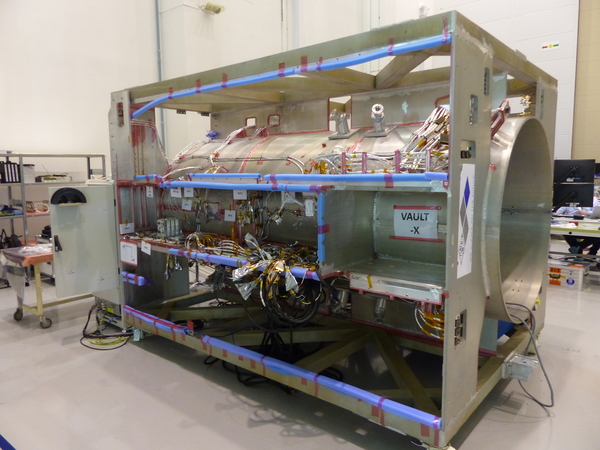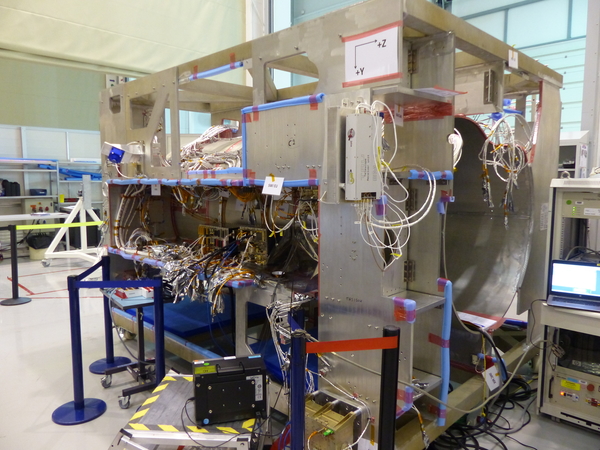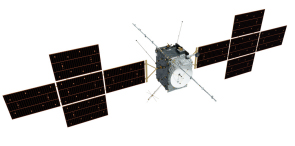#4: JUICE engineering model ready for testing
11 December 2018
The JUICE engineering model spacecraft test readiness review was completed successfully on 2 October, and the first engineering model instruments are now being delivered and tested. |
| JUICE engineering model. Credit: Airbus Defence and Space |
A major step in the development of ESA's upcoming JUICE mission to the Jupiter system is the start of integration and testing of the spacecraft engineering model at the facilities of prime contractor Airbus Defence and Space in Toulouse, France.
The engineering model is a full size, 3D model of JUICE. It has been built to be representative of the flight model – the spacecraft that will be launched into space – in terms of dimensions, electrical harness routing, software, mechanical and electrical interfaces.
 |
| JUICE engineering model. Credit: Airbus Defence and Space |
Depending on the specific needs of each project, the engineering model can be built in two or three dimensions. In the case of JUICE, it was decided to build a 3D engineering model of the spacecraft to verify at an early stage the challenging electromagnetic requirements of the mission, performing electromagnetic compatibility tests on a fully representative model.
 |
| Artist's impression of the JUICE spacecraft, as of July 2017. Credit: ESA/ATG medialab |
Following the JUICE flight model spacecraft test readiness review, in October 2019, the engineering model will be used to test procedures and study functional issues that may arise during the development testing of the flight model. The engineering model will also be used, on ground, in support of the actual spacecraft operations after launch.
Four engineering models of JUICE instruments were delivered to Airbus Defence and Space and they were then mounted on the engineering model spacecraft. The first functional tests of these instruments are ongoing.
The first to arrive was the J-MAG instrument, a magnetometer designed to characterise the Jovian magnetic field and its interaction with the internal magnetic field of Jupiter's giant moon Ganymede, and to study subsurface oceans of the planet's icy moons.
The other instruments that were integrated in the engineering model spacecraft were the UV spectrometer (UVS), the Sub-millimeter Wave Instrument (SWI) and the PEP-Hi sensor, part of the Particle Environment Package (PEP).
MAJIS, the Moons and Jupiter Imaging Spectrometer, is expected to be delivered and integrated in the engineering model spacecraft before the end of 2018.
The five remaining engineering model instruments are scheduled for delivery to Airbus Defence and Space by mid 2019.
Meanwhile, the JUICE Critical Design Review is scheduled to start on 14 December 2018.
About JUICE
JUICE – JUpiter ICy moons Explorer – is the first large-class mission in ESA's Cosmic Vision 2015-2025 programme. It will complete a unique tour of the Jupiter system that will include in-depth studies of three potentially ocean-bearing satellites, Ganymede, Europa and Callisto.
The Jupiter tour includes several flybys of each planet-sized world, culminating with orbit insertion around Ganymede, the largest moon in the Solar System, followed by nine months of operations in its orbit.
JUICE will carry the most powerful scientific payload ever flown to the outer Solar System. It consists of 10 state-of-the-art instruments plus one experiment that uses the spacecraft telecommunication system with ground-based instruments.
JUICE's instruments will enable scientists to compare each of these icy satellites and to investigate the potential for such bodies to harbour habitable environments such as subsurface oceans. They will also carry out observations of Jupiter, its atmosphere, magnetosphere, satellites and rings.
About the instruments
The principal investigator institutes of the instruments mentioned in this article are:
J-MAG: Imperial College London, UK;
UVS: South West Research Institute, USA;
SWI: Max-Planck-Institut für Sonnensystemforschung, Germany;
PEP-Hi: Swedish Institute of Space Physics, Kiruna, Sweden with Johns Hopkins University Applied Physics Laboratory, USA;
MAJIS: Institut d'Astrophysique Spatiale, France.


